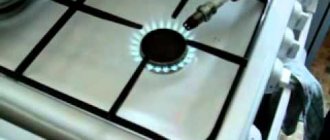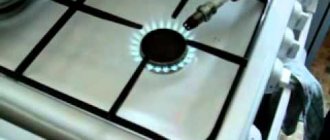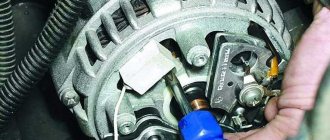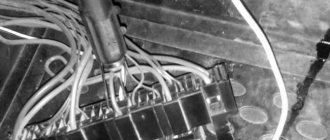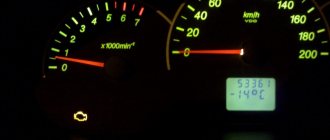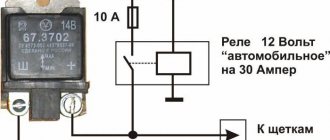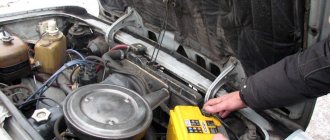A dead battery that refuses to start the engine in the morning is a situation familiar to every motorist. Under normal conditions, this happens infrequently and is the result of driver forgetfulness. But what to do if the battery is discharged not because the headlights or interior light bulbs were left on? Most likely, the car has a current leak in the on-board network, which leads to a rapid discharge of the battery. Let's try to figure out what this parameter depends on and how to solve this problem.
Why does my battery drain quickly?
Experts identify 5 reasons why your car battery drains quickly. In order to correctly navigate and correct the situation, they must be studied in advance.
The battery life is completely exhausted
This is considered the most common reason why the battery in a car quickly runs out. This situation arises after 3-5 years, when the power source and its elements are worn out. After prolonged use, the battery loses not only its charge, but also its capacity.
The problems with lead acid batteries are related to the sulfation process. Its essence lies in the gradual accumulation of salts on the plates. This provokes a decrease in the working area at the terminals and deterioration of contact with the electrolytic composition.
In order to get rid of this problem, perform the following steps:
- To prevent rapid battery discharge, a reduction in the number of short runs is required. After all, constantly starting the engine consumes a lot of energy. When moving a short distance, the expended energy is not fully restored.
- The car battery is periodically charged using a charging unit. After all, the source deteriorates if it remains in a discharged state for a long time.
- Deep discharge of the battery is prohibited. After all, this provokes a rapid loss of capacity and a reduction in working life.
- Periodic check of electrolytic composition. Not only the composition level is monitored, but also the condition. Lead plates must be in an electrolytic composition.
- Carrying out maintenance and prevention.
Such measures are effective for sources that have been in operation for 1-2 years. For a period of 3-4 years, a new battery is required.
Problems with the generator
It is not uncommon for a car battery to die because the generator is not functioning well. If the battery does not receive the required charge from the generator, it will be completely discharged within a short time after stopping.
What to do in this case? To test the functionality of the generator, use a multimeter. Next, the standard and additional equipment is launched. And only after that the voltage is established using a multimeter. Its value should be 13-14 V. If lower values are displayed on the multimeter monitor, then the required charge is not supplied to the source.
Reasons why the generator does not transfer charge to the battery:
- The alternator belt has become deformed or broken.
- Insufficient belt tension.
- Violation of the integrity of electrical wiring and conductive contacts.
- Poor functioning of the voltage regulator.
- The diode bridge has failed.
To determine the exact cause of the deterioration in the performance of the generator and its elimination, specialists from a car service center are involved. Long-term use of a faulty generator leads to the fact that even a new battery is replaced.
Unacceptable temperature conditions
The question of why a vehicle battery is discharged often arises in winter. This is because the electrolytic composition becomes thicker at low temperatures. As a result, contact deteriorates.
In order to prevent such an outcome, the charge level of the car battery is monitored more carefully. To do this, evaluate the density of the electrolytic composition. There are tables online that give approximate values.
When operating vehicles in winter, follow the following rules:
- You should not leave an uncharged battery.
- The density of the electrolytic composition increases by 0.01-0.03 g/cm3.
- The power supply is quickly supplied with a special case.
- You should not leave the battery in the cold. Responsible drivers move the power source to a warm room.
Leakage current
Often the question of why the battery drains quickly also arises due to current losses. Current leaks occur due to:
- Presence of oxides on conductive terminals.
- Damage to the insulating layer, deterioration of electrical wiring.
- Incorrect connection of electrical equipment.
Determination of leakage current is carried out in several stages:
- Removing the ignition key.
- Opening windows and closing doors. This is because the central locking is blocked while checking the power source.
- Disabling equipment and devices that are connected to the electrical system.
- Removing the negative conductive terminal.
- Measuring leakage current using a multimeter.
The norm is 15-70 mA. If other parameters are displayed on the monitor, then you should involve a specialist.
What mistakes do drivers make?
Batteries run out due to the irresponsible attitude of drivers. Leaving the headlights and heating on all night leads to discharge.
You will have to correct the situation in domestic vehicles yourself. For new foreign cars, manufacturing companies have prepared devices that turn off headlights and heaters.
Reasons for battery discharge.
How to prevent battery drain?
To maintain a new or used battery in working condition, preventive measures are carried out.
- 1-2 times a year, the battery is recharged from a charger that is connected to the network. Experts recommend conducting training cycles.
- After recharging the power source, check the density of the electrolytic composition and its level. Such actions are not performed if a maintenance-free device is installed in the vehicle.
- Maintaining electrical wiring and devices in working order. Even minimal violations provoke current leakage and battery discharge.
- Cleaning the battery case.
- Cleaning terminals and other elements.
Causes of car battery boiling
Boiling of the power source provokes problems with electrical wiring and equipment, and starting the motor. If the battery gets very hot, then:
- Lead plates and leads are gradually destroyed.
- The likelihood of the lead plates shorting out and the source exploding increases.
- Moving with a boiling power source provokes damage to wires and the vehicle body.
- If the battery boils, the charging current also increases. This negatively affects the condition of the generator.
What to do if the battery dies overnight
Before starting the study, you must fully charge the battery from the network station. If you have a hybrid or low-maintenance device, you need to measure the density of the electrolyte in the banks and its level. It is necessary to add distilled water to the elements if its level is less than the norm of 1.2-1.5 cm, followed by recharging. The maintenance-free sealed battery is easy to recharge.
The reasons why a car battery dies overnight can be:
- The battery does not hold a charge - it was discharged to zero, it was frozen, it was old;
- problems in the generator;
- any device that consumes current is faulty;
- operation at low temperatures;
- not turned off at night, one of the consumers is in sleep mode, except for the alarm and remote control.
Under normal conditions during idle periods, energy consumption should be less than 0.05 A, all large losses are parasitic.
Why doesn't the starter turn?
Contacts
The simplest and most easily remedied reason is poor contact; there is no difference between the carburetor and the injector. There are quite large currents in the starter, generator, and battery circuits; the slightest deterioration in electrical contact leads to local heating, oxidation, a further increase in current resistance and a parasitic voltage drop.
The terminals of the VAZ 2110 battery must be removed, cleaned of dirt, the contact surface must be treated with fine sandpaper, carefully placed on the battery contacts without distortion and tightened with a wrench. The wires from the battery to the housing, generator, starter, as well as the connection to the ground of the generator and starter are checked. The contacts are cleaned, the nuts and bolts securing them are tightened.
You can learn more about the causes of starter malfunction in a VAZ 2110 car here: https://vazweb.ru/desyatka/elektrooborudovanie/ne-krutit-starter.html
Battery
The most obvious reason is battery failure.
If it is more than five years old or it has been completely discharged a couple of times (for example, they forgot to turn off the lights or lights in the cabin when leaving the car for a long time), then this is completely natural.
Such a battery will externally charge (quickly due to the sharply decreased capacity), but will not be able to provide the starting current necessary for starting. You can drive with it, but starting a cold car, especially when the temperature drops, is impossible.
If the bank fails or there is an internal short circuit, the output voltage decreases, which is easily determined with a multimeter. There is only one way out - replacing the battery.
Leakage current
The most hidden reason is a large leakage current. When all consumers in the car are turned off, the battery still gradually discharges; this is a self-discharge current due to the design and operating principle of the battery.
Additional leakage current is caused by incorrectly connected devices, damaged wiring and, oddly enough, dirt on the battery case. We clean the outside of the battery from dirt with a rag, especially the upper plane and near the terminals, disconnect the negative wire, insert a multimeter into the gap in current measurement mode to the maximum limit.
Lowering the measurement limit, we obtain the first values. For a VAZ 2110, a current of 3–5 milliamps (mA) will be an excellent indicator, up to 15 mA is normal (especially when the alarm is on), with a value of more than 30 mA (for an injector 50 mA), you need to look for a “malicious” waste of electricity.
Reasons why your car battery dies overnight
There is a great temptation to install modern communication systems, climate control equipment, and powerful headlights in your car. But all these devices take energy from a generator, which is not designed for excess consumption. As a result, a car whose mileage between starts does not exceed 20 minutes does not have time to charge the battery overnight. Additional energy will be spent on signaling and circuit protection during long periods of inactivity.
The standard signal consumption is small, but there are also parasitic currents. Somewhere the old wiring is exposed and touches the body. Perhaps the device circuit is assembled incorrectly, does not turn off, and operates in sleep mode. Often the radio remains plugged in, the sound is turned off, and the device consumes current in standby mode. As a result, it turns out that the car’s battery died overnight, which is why it won’t start. Testing will help you find all sources of leakage from the on-board system, detecting losses from each source.
No charging
Indicator
On carburetor and injection VAZ 2110, the lamp on the dashboard, indicating a malfunction in the battery charging circuit, is connected via a relay to the output of the generator.
In normal mode, it lights up when the ignition is turned on; after the engine starts running, if the generator is working, it goes out.
If the lamp is constantly on and there are no problems with the battery, then the warning lamp relay and the generator-relay-dashboard wiring are checked. If the light does not light up when you turn on the ignition, then most likely it is the one that has failed.
If there is a simultaneous indication of a malfunction and the battery is undercharged, the cause must be sought in the generator and relay regulator, although it is possible that the drive belt may simply slip due to a loose fastening.
Voltage regulator
On a running car, disconnecting the negative battery from the battery when the generator is faulty will cause the engine to stop. Such a check cannot be carried out on an injector, only on “old” eight-valve engines. The relay regulator (“tablet”) ensures that the generator output voltage is maintained within the range of 13.2–14.7 volts.
The voltage at the battery terminals, with the engine running at different speeds, should not go beyond this range (a sag at the time of start-up is acceptable). Structurally, for engines with both a carburetor and an injector, the regulator is located in the generator; in case of defects, it is replaced entirely.
Diode bridge
Diode breakdown also leads to a lack of output current for charging; often such a defect occurs after a short circuit in the cigarette lighter socket, when connecting “left-handed” electronic car accessories, or after incorrectly connecting the polarity of the battery terminals.
Generator belt
You don’t need to be an expert to understand such a basic thing - if the battery is not recharged under load, it will soon run out.
This means that there will be no spark and the engine will stop. The generator recharges the battery while driving. This electric machine can be found under the hood of any car with an internal combustion engine. And you should look for it in a compartment of other attached equipment, such as a cooling system pump or a hydraulic booster. The first step is to assess the serviceability of the belt drive. Is the belt torn? - this is the first question that a driver should ask himself when standing on the side of the road with an empty battery. Indirectly, a broken V-belt product is indicated by a constantly glowing battery icon on the instrument panel. Well, under the hood it is impossible not to notice only in one case - when the engine compartment is decoratively covered with plastic covers.
A slight undercharging results from insufficient tension of the alternator belt. Weak effort can be easily determined by the whistle that comes from under the engine compartment when starting the engine or sudden throttle changes. By the way, this is the case when a rubber product needs tightening. However, such a symptom also indicates the end of the service life of the part. The explanation for this is simple - closer to the fifth year of operation, the rubber loses its quality and, at extreme conditions, begins to slip along the grooves of the pulleys, emitting a nasty whistle.
Replacing the diode bridge
To replace the relay regulator and the rectifier unit (another name is a diode bridge), you need to disassemble the generator, first removing it from the VAZ 2110, for which you will need 13, 10 keys and a Phillips screwdriver.
To remove the generator you need to:
- Disconnect the battery terminals;
- Remove the rubber cap on the generator and unscrew the nut securing the wires with a 10 mm wrench;
- Pull out the connector;
- Loosen the tension mechanism nut, unscrew the tension bolt and remove the bracket;
- Move the generator with the mounting tool, loosen the belt and remove it;
- Using a 13mm socket, unscrew the 3 bolts from below and remove the generator along with the lower bracket.
For further work, the back cover is removed; it is held in place by 3 plastic latches. Use a Phillips screwdriver to unscrew two screws and remove the relay combined with the brush assembly. To remove the rectifier unit, you need to unscrew the 4 screws securing it and the capacitor, as well as the ends of the windings.
The relay can only be replaced as a whole; there are several models on sale, even with a “summer-winter” switch for selecting the output voltage. It is also better to replace the diode bridge as an assembly.
Reasons for battery failure
There can be many reasons for battery failure. Below is a list of reasons:
Recommendations
Bearings, brushes and stator and rotor windings are also checked for opens and short circuits. It is better to entrust rewinding of the generator, if necessary, to a professional service. Assembly is carried out in reverse order.
If the battery on the VAZ 2110 injector runs out even after a short stay, then do not rush to throw it away. Cleaning contacts and disconnecting “wrong” consumers can solve this problem.
And if the charging indicator lamp also lights up, then the fault must be looked for in the generator. Keep an eye on the condition of your car and it will not let you down.
Current consumption of service on-board devices, parasitic currents
If all on-board internal and external consumers are in working order, the connection diagram is assembled correctly, they are completely disconnected from the network, and do not remain in sleep mode. Measurements with connected alarm, blocking and contactless immobilizer do not exceed the total consumption of 0.05 - 0.07A. With this consumption, even in winter, the battery will cope with starting the engine in the morning.
If a leak is detected, it is necessary to conduct a full diagnostic of devices and instruments powered from the on-board power supply. The reason may be incorrect connection of service equipment or powerful multimedia systems. Even a complex gadget power supply circuit can cause parasitic losses.
How to solve the problem with unexpected current leaks
So, is it possible to determine that the battery is draining due to leaks? Definitely, but you need a multimeter for this. Check algorithm:
- we turn off all electricity consumers (of those that are turned off);
- turn off the ignition, remove the key from the lock;
- go to the engine compartment, disconnect the battery terminals;
- we close the car doors, but leave the windows open;
- switch the multimeter to current measurement mode (with a maximum of 10 A);
- connect it to the battery terminals, turn it on and record the indicators;
- repeat the procedure at intervals of 1 hour.
If it turns out that during this time the device readings have changed by more than 70 mA, it can be argued that this is an excess of the norm and the source of the leak should be looked for.
To determine what exactly is draining the battery, with the ignition on, you need to alternately turn off the standard and installed by the car owner electricity consumers and carefully observe the readings of a multimeter operating in ammeter mode. The essence of the test is to detect a device that, after being turned off, continues to consume electricity, albeit in small quantities. It is clear that for these purposes a measuring device with high accuracy will be required.
Remember that the battery may be discharged for other reasons than those listed in this article. For example, rapid discharge is observed at sub-zero temperatures, when electrical appliances are connected incorrectly, or when the permissible load on the generator is exceeded.
Consequences of tuning
In an effort to increase their comfort and ensure the safety of their car from outside attacks, people sometimes forget to correlate the capabilities of the car with the installed equipment. First of all, this concerns acoustics. Meanwhile, cool car audio includes a whole bunch of modern options: a radio, a drive, a subwoofer, an amplifier, plus powerful speakers. In some cases, the kit is supplemented with a TV, and copper wiring, capable of passing the current of a stationary power plant, connects everything into a single whole. A car generator is simply not able to supply all installed equipment with electricity, which is why the battery is discharged.
Another reason
early discharge may become an alarm. Usually - incorrectly installed, since all types of signaling are tailored specifically to the capabilities of the generator and battery. If it begins to discharge shortly after equipping the car with a new alarm system (or audio system), after checking the terminals there is no need to look for other reasons.
A new battery may also stop holding a charge if it is supplied that does not match the car model. Moreover, it can be either insufficient or excessive capacity. In the first case, the battery is not able to feed all the on-board equipment, as a result of which it immediately runs out; in the second, the generator cannot sufficiently power it. Constant undercharging causes regular discharge, and soon – battery failure.
